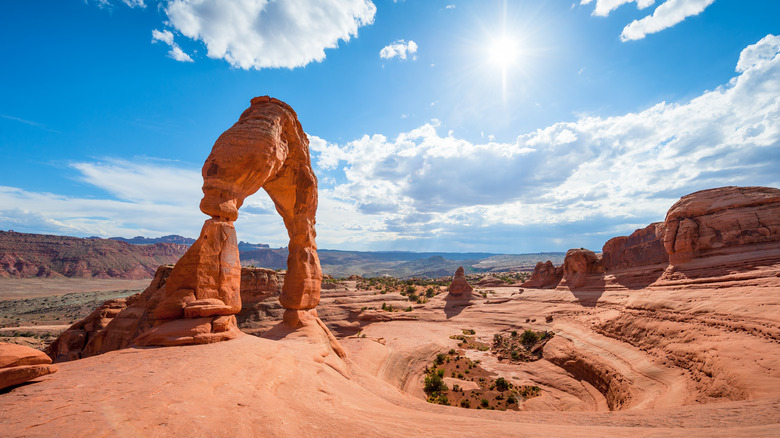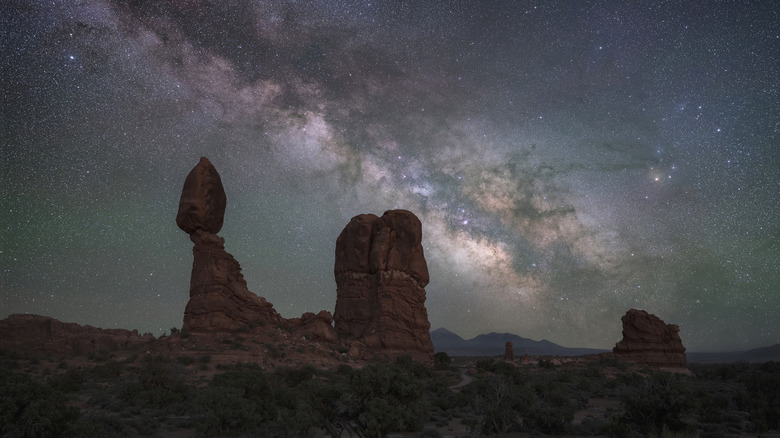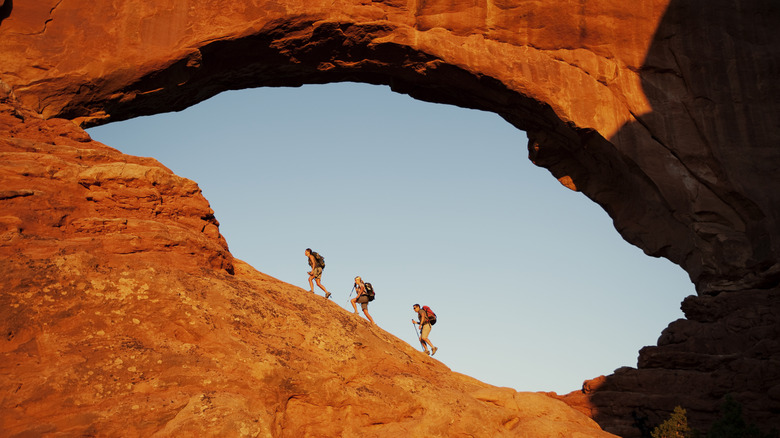Hike Up To An Incredible Stone Arch At This Popular Western US National Park
Nestled in eastern Utah, Arches National Park feels like it's out of this world. A varied and dramatic landscape made up of contrasting colors, landforms, and textures, the park is located just 5 miles north of the city Moab and has become a haven for nature enthusiasts and landscape photographers alike. Covering over 76,000 acres — and home to more than 2,000 stone arches, each with its own unique shape and story — Arches National Park is, without a doubt, one of the most photogenic, must-visit stops on any trip along the American West.
The park's most famous resident — Delicate Arch — helps to draw in more than 1.8 million visitors each year. Standing at 46 feet high and 32 feet wide, Delicate Arch is the largest free-standing arch in the park. And with a 3-mile roundtrip trail leading all the way up to the base and back, exploring this natural marvel makes for a truly unforgettable experience.
But how did these arches even form in the first place? One word: erosion. Made from Entrada Sandstone (a porous type of rock) and combined with rainwater, extreme temperatures, and underground salt that eroded the rock layers, these magnificent arches were sculpted over time — a million years, to be precise.
Exploring the best of Arches National Park
Beyond Delicate Arch, there's plenty more to see and explore at Arches National Park. For starters, the popular Park Avenue and the Courthouse Towers area is brimming with monoliths and skyscraper-like rock formations that tower over visitors' heads. Easily accessible with a 2-mile there-and-back trail — even better, the trail is completely flat — you'll be rewarded with views of the La Sal mountains once you reach the end of the path.
Another can't-miss spot is Balanced Rock. A work of nature's greatness at 128 feet tall, the massive boulder weighs 3,600 tons and appears to be balancing precariously on top of another. While the formation can easily be spotted from the park's road, nothing beats tackling the 9.2-mile hike from the official visitor center to the base of the structure. Want to elevate the experience? Spend the night — either at Devil's Garden Campground for $25/night or backcountry camping — and enjoy mesmerizing star-lit skies for an experience that's equal parts magical and breathtaking.
Last, but definitely not least, there's the Windows Section. Home to even more of the park's iconic formations — including North Window, Turret Arch, Parade of Elephants, and Double Arch — the area requires a little more effort in terms of hiking, but is still accessible for most visitors who don't mind dealing with the occasional stone steps, slopes, and uneven surfaces.
Planning your visit
The most important thing to keep in mind when planning your visit to Arches National Park is that you'll need to reserve a timed entry ticket starting from April 2024. A new system that's being implemented to manage the number of people in the park, it's meant to provide a more sustainable (and less crowded) experience for everyone. In addition to this, general admission tickets are also required and start from $15 per person, $20 for motorbikes, and $30 for private vehicles.
As for choosing the best time to visit, it all depends on what you're after. The park typically reaches peak tourist season between April-May and September-October, during which time you can expect low temperatures between 30-50º Fahrenheit and highs of 80º Fahrenheit. Meanwhile, summertime comes with extreme temperatures that can easily climb above 100º Fahrenheit — which will make things a little more challenging if you're planning to hike. On the other end of the spectrum, winters are typically very cold, with high temperatures hovering between 30º to 50º Fahrenheit.
Whatever your choice, Arches National Park promises spectacular scenery and opportunities for outdoor exploration throughout the seasons.


